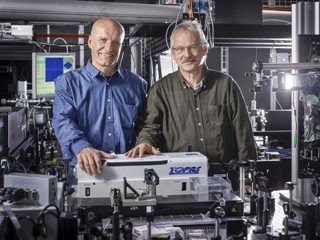Feb 19 2015
For many years, PSI researchers have been testing experimental methods that will provide insights into novel materials for electronic devices. Using a special trick to make the Swiss Light Source (SLS) at PSI generate light with similar properties to that of PSI's x-ray laser SwissFEL, the researchers were able to demonstrate that the experiments planned for SwissFEL are possible and they are now building an experimental station at SwissFEL.
 PSI Swiss Light Source Generates Light with Properties Similar to SwissFEL X-Ray Laser
PSI Swiss Light Source Generates Light with Properties Similar to SwissFEL X-Ray Laser
The x-ray laser SwissFEL is currently under construction at PSI. The biggest part of the facility, which will be over 700 metres long, will generate the special x-ray light which will reveal previously unseen phenomena from the world of atoms and materials. But just as a photographer is unable to take pictures with a flash gun alone, experiments at SwissFEL will also require the equivalent of a camera and a photo studio in addition to the light... The so-called experimental stations take on this role at SwissFEL, where its light shines through the material sample that the researchers want to study. And much like the chip in a digital camera, a detector registers the light that has been scattered by the sample and is now carrying information about its composition.
Currently, three experimental stations are planned at SwissFEL. The PSI physicists Gerhard Ingold and Paul Beaud are responsible for the experimental station ESB, where researchers want to probe the behaviour of materials that could help provide electronic devices with unexpected capabilities in future. The two researchers are well-equipped for the task. Together with Steven Johnson, now a professor at ETH Zurich, they have already been conducting experiments that resemble those at SwissFEL since 2006. They were able to use a trick to generate light with similar properties to that of SwissFEL at the measurement station FEMTO at PSI's Swiss Light Source (SLS).
Short flashes from the SLS
Like SwissFEL, the SLS also generates x-ray light. While the SwissFEL light will appear in extremely short, intense flashes, the SLS emits comparatively long x-ray flashes. The trick induces the SLS to generate flashes of light for the FEMTO measuring station that are almost as short although nowhere near as intense as SwissFEL's. This enables the researchers to test what one of SwissFEL's main tasks will be: to depict individual steps of extremely rapid changes – much like photography with a short exposure time.
Nevertheless, the short exposure time is only part of the challenge: the researchers especially want to observe the very first moments of any change. To get an idea, one can think of a drop of ink falling into a glass of water. Initially, the ink makes pretty patterns. After a certain amount of time, however, it spreads and dyes the water blue. This happens even faster if the water is stirred. But why is this the case? Are the small whirls the spoon creates in the water responsible? In order to find out, it helps to photograph the patterns, with a short exposure time to prevent the images from looking blurred. With a whole series of photos, the first taken shortly after the drop hits the water, the next ones at short intervals after, exactly how the whirls develop will be shown.
At the FEMTO measuring station and the experimental station ESB, the principle of the experiment is similar, even if the times involved are a billion times shorter and the researchers aren't concerned with drops of ink. Instead, they are interested in the phase transitions where the properties of a material fundamentally change under an external influence. “For instance, there are materials that don't conduct any electricity at first, insulators that turn into a metal if heated. This kind of a material could serve as a switch in electronic devices, where the electricity would be switched on through heating,” explains Paul Beaud. The more strongly the material is heated, the more vigorously the atomic building blocks inside move. In reality, this seemingly chaotic movement is a combination of a large number of different forms of motion – referred to as “modes” by physicists.
Stimulating change specifically
It is possible that only a single mode may be responsible for the change from insulator to metal. In order to examine how the change comes about, one would have to trigger this one mode only. “We want to achieve this by illuminating the sample with a tailor-made laser. Using the x-ray light from SwissFEL, we could then follow what happens inside the material,” says Ingold. In a very short time interval, the energy that the laser has added to one mode spreads to all modes – just as the initially concentrated drop of ink spreads through the water. In other words, for the researchers to be able to study the influence of the laser precisely, the flashes from SwissFEL that shine through the sample need to follow each other in quick succession and have to start a very short time after the laser flash – which, in this case, means a few hundred billionths of a second.
“At the FEMTO measuring station at the SLS, we have shown that such experiments are possible. Without these preparations, it would have been a lot harder for us to put forward a design for the experimental station ESB,” explains Ingold. “However, we can only study certain aspects of the processes at FEMTO. We often had to explain to colleagues who were looking to make measurements here that their experiments couldn't be done. However, at SwissFEL, we'll be able to completely study the processes in complex and technically interesting materials.”